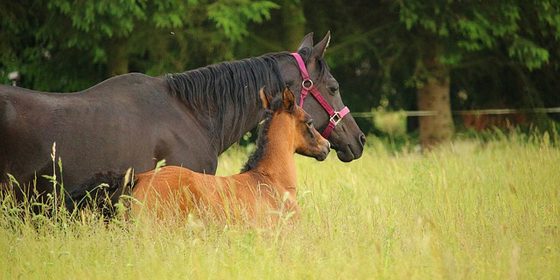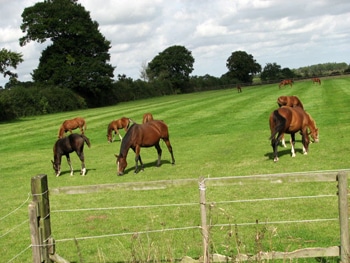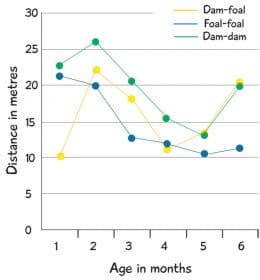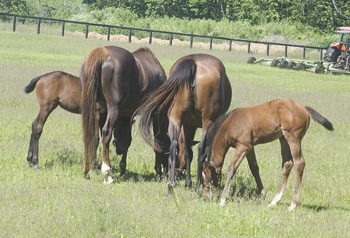Have you ever watched a mare and her foal together? Newborn foals tend to stay close to their mother’s side. Over time, as the foal gets older, they venture further apart. Researchers in Japan were curious about how this distance changes over time. To study mare and foal behaviour, they attached GPS devices to the halters on a group of mares and their foals.
By recording the positions of the mare and her foal at the same time, they could mathematically calculate the distance between them.
By monitoring this distance over time, they observed changes in this distance as the foal grew.
Six Thoroughbred mares and their foals (four colts and two fillies) on a private farm in Hidaka, Japan, took part in the study.
Once a month, the researchers attached small GPS units to the bottom strap on the horses’ headcollars and recorded the animals’ position every five seconds.
These sessions were conducted for a period of 600 min from morning to evening during the first and second months of foal age and for a period of 1,000 min from the afternoon to the next morning during the third to sixth months of foal age.
Horse Talk – headcollar: another word for halter.
1. What fraction of the foals in the study were fillies?
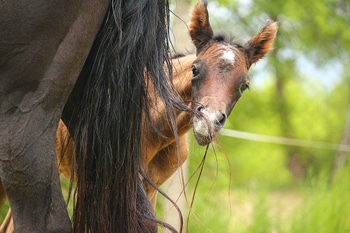
3. How many times a minute were the mares’ and foals’ positions recorded?
4. How many times an hour were recordings taken?
5. How many hours long were the recording sessions in the foals’ first two months of life?
6. How many hours long were the recording sessions when the foals were three to six months of age?
Previous studies of mare and foal behaviour have relied on observation. Using GPS technology provided the researchers with a more objective and less labour-
Science Talk – objective: not influenced by personal feelings or opinions when considering and representing facts.
Along with monitoring the distances between dam and foal, the researchers also tracked distances between mares and distances between foals, resulting in three sets of data. Their data is displayed in the graph to the right.
7. In the first month of life, what was the average distance between a dam and her foal?
8. Which of the three groups stayed furthest apart during the course of the study?
9. Which group experienced the biggest change between the first and second month?
10. Which group was closer together in the second month than they were in the first month?
11. Between the first and sixth month, distance decreased in which group(s)?
12. What was the average distance between a dam and her foal in the sixth month?
When you observe horses, what questions come to your mind? There are lots of questions still to be answered in the horse world. Can you see yourself researching horses someday?
Answers:
1. What fraction of the foals in the study were fillies?
Answer: 2 (number of fillies)/6 (total number of foals) = 1/3. One third of the foals in the study were fillies.
2. What fraction of the foals were colts?
Answer: This can be answered in two ways.
Method 1: You already know that 1/3 of the foals were fillies. Therefore 2/3 of the foals were colts.
Method 2: 4 (number of colts)/6 (total number of foals) = 2/3. Two thirds of the foals were colts.
3. How many times a minute were the mares’ and foals’ positions recorded?
Answer: 60 sec (number of seconds in a minute) ÷ 5 sec (frequency of position records) = 12. Positions were recorded 12 times per minute.
4. How many times an hour were recordings taken?
Answer: 60 min (number of minutes in an hour) × 12 (number of times positions are recorded per minute) = 720. Positions are recorded 720 times per hour.
5. How many hours long were the recording sessions in the foals’ first two months of life?
Answer: 600 min ÷ 60 (number of minutes in an hour) = 10 hours. Recording sessions lasted 10 hours during the foals’ first two months of life.
6. How many hours long were the recording sessions when the foals were three to six months of age?
Answer: 1000 min ÷ 60 (number of minutes in an hour) = 16.67. Recording sessions lasted 16.67 hours, when the foals were three to six months of age.
7. In the first month of life, what was the average distance between a dam and her foal?
Answer: 10 m
8. Which of the three groups stayed furthest apart during the course of the study?
Answer: The dam to dam distance was furthest apart.
9. Which group experienced the biggest change between the first and second month?
Answer: The biggest change took place in the dam to foal distance.
10. Which group was closer together in the second month than they were in the first month?
Answer: foal to foal
11. Between the first and sixth month, distance decreased in which group(s)?
Answer: Foal to foal and dam to dam.
12. What was the average distance between a dam and her foal in the sixth month?
Answer: The average distance between a dam and her foal was a little more than 20 m by the sixth month.
Common Core:
4.NF.A – Extend understanding of fraction equivalence and ordering
4.MD.A.1 – Convert time units
5.NBT.A.3 – Model decimals and fractions
6.SP.B – Interpret line graphs
Photos:
Mare & foal; Public Domain
Thoroughbred mares and foals at Brookfield Stud by Evelyn Simak; CC BY-SA 2.0
Foal peaking out by rihaij; Public Domain
Thoroughbred Mares & Foals KY by Jean; CC BY 2.0


